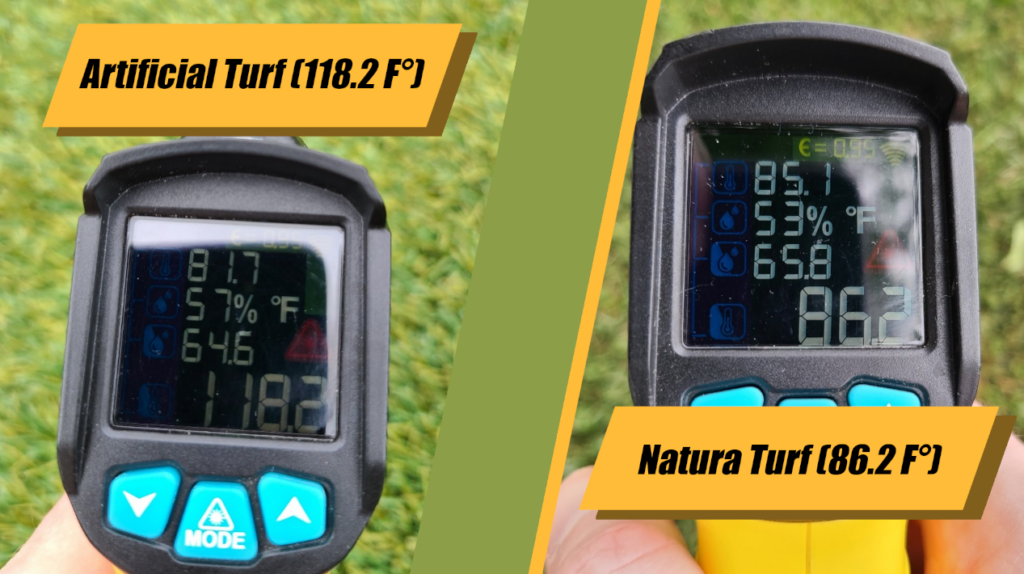
In the Summer months, it’s crucial to monitor what surfaces are safe for dogs to walk and play on in terms of temperature. The American Kennel Club recommends caution on asphalt surfaces when the ambient temperature reaches 85 degrees Fahrenheit or higher—but how hot does artificial turf get? What about other surfaces?
Grass is usually a better bet for safe surface temperatures in the heat due to several factors. Grass converts solar energy into growth via photosynthesis whereas other surfaces simply reflect heat. Grass also has a high surface area including many tiny, shaded areas between the blades, so heat dissipates quickly. Grass also has a natural water content, meaning a significant amount of energy is required to change its temperature.
Is it really such a big deal that dogs get a little warm? Yes, it is. We’ve all heard the (false) claim that dogs cannot sweat; the truth is, they do sweat but in a very limited way, only through the few sweat glands on their paws and usually this sweat isn’t nearly as effective at cooling dogs’ bodies as human sweat is for our own bodies. That’s why dogs pant: they breathe in drier, cooler air and exchange it for warm, moist air in the lungs.
That means dogs aren’t quite as good at regulating their body temperatures in the heat—particularly if the ambient air is moist as it so often is here in humid Missouri. Much like humans, dogs reach a danger zone when their internal temperature is at or above 102 degrees Fahrenheit. Refer to the American Kennel Club’s overheating warning signs if you’re concerned for your dogs’ safety.
It’s important to keep dogs off hot surfaces as the contact can quickly heat up their core temperatures—but more superficial injuries may also occur on dogs’ paw pads if they are in contact with hot surfaces. It only takes 60 seconds of contact on 125-degree Fahrenheit pavement for paw damage to occur. Generally, if you can comfortably place the back of your hand on the surface your dog will walk on, it is likely safe for them over shorter periods. If the surface is too hot, dogs will limp, lick their paws, develop bleeding or irritation on their pads, or vocalize similar to other paw injuries.
Overall, it’s not simply a matter of comfort when it comes to temperature and dogs. They are worse at regulating their temperature than us and (obviously) less articulate if they do get hurt, often leading to worse injuries as the problem isn’t quickly identified.
We strive to create products that keep dogs and their people happy and healthy, so we had to know how Natura turf stacks up against some of its alternatives: traditional artificial turf and natural grass. We also wanted to know how hot sidewalks get, as they’re typically seen as danger zones for dogs in hot weather. We went out into the field with our trusty laser thermometer to get to the bottom of artificial turf temperature. We love a good experiment around here!
We set out on our data-gathering journey on an ideal day for the readings: a sweltering late-June Thursday in St. Louis, Missouri. The forecast read 100 degrees Fahrenheit on the dot, and you could certainly feel every degree. Bear in mind, though it was very hot, the sky was somewhat overcast, meaning all the surfaces we tested are likely to be even hotter on a clear and similarly warm day.
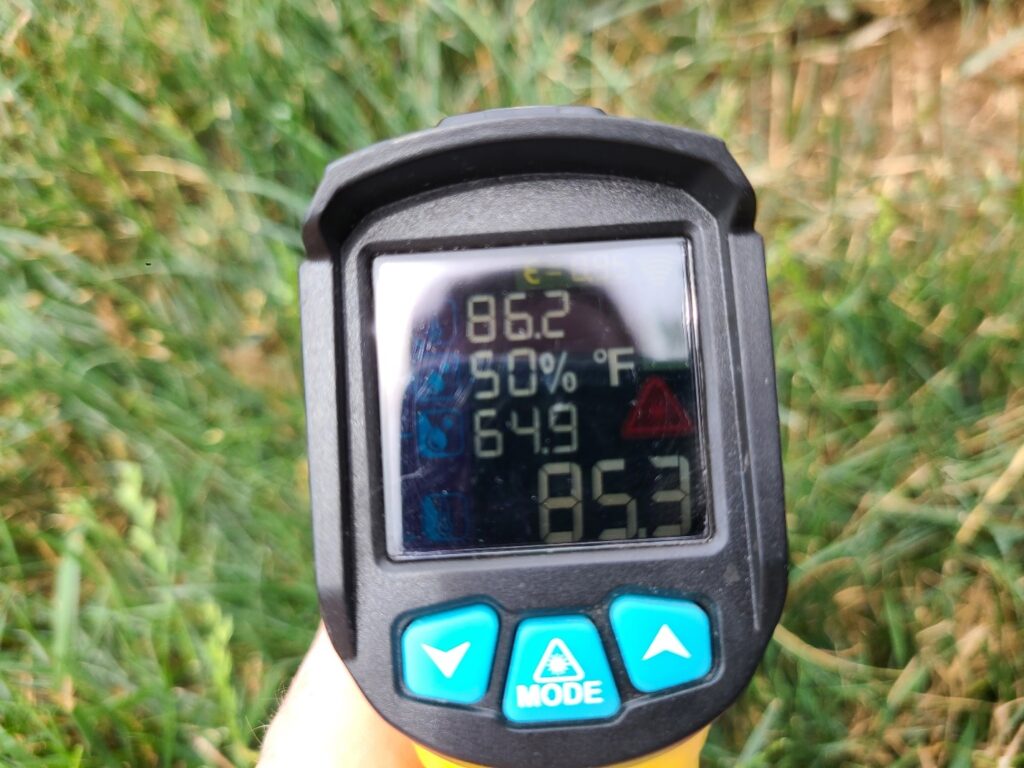
Every good experiment needs a control group, and grass is as standard as it gets. Even on such a hot day, you can see that grass’s natural properties keep it cool to the touch. Dogs can cool themselves on grass and walk on it without issue at this temperature. To a dog, a patch of grass like this might look like a hidden oasis on a hot Summer day.
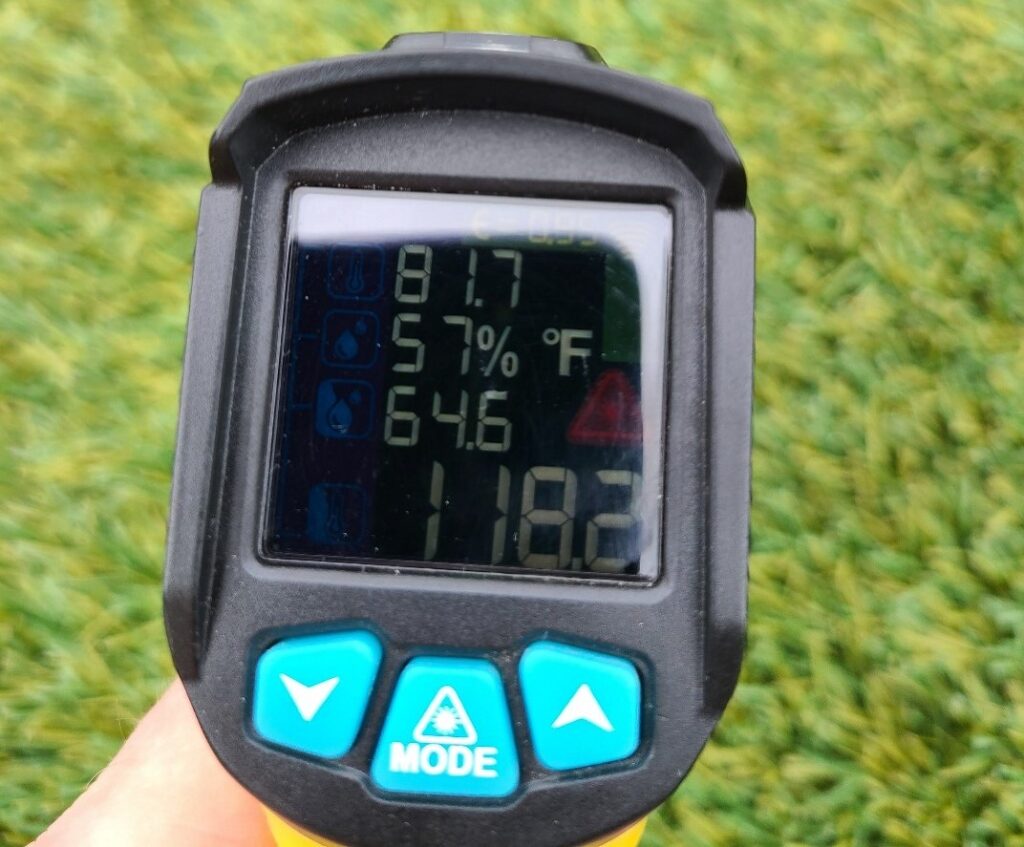
We were surprised to find that the artificial turf in this dog park was at a likely dangerous temperature for dogs at 118 degrees Fahrenheit. What looks like an inviting and cooling surface to a dog turns out to be a possible hazard. It’s this very danger that likely convinced the property owner to put up a warning sign.
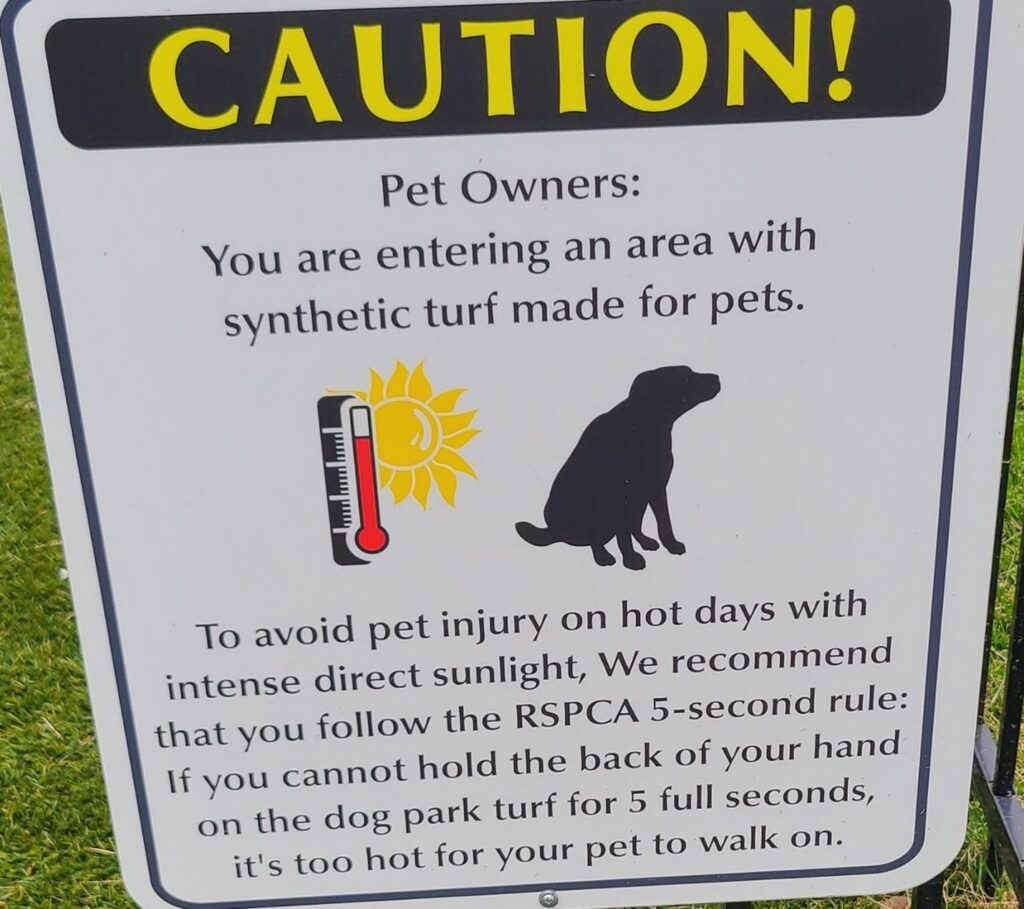
This is an important lesson for dog owners and caregivers everywhere: just because a surface looks safe for dogs in hot weather doesn’t mean it necessarily is. As the sign suggests, placing the back of your hand on the turf for five seconds is a useful way to measure dog safety in high temperatures—but it’s also useful to remember to double check if you’re looking at real grass or artificial turf as they clearly react to heat differently.
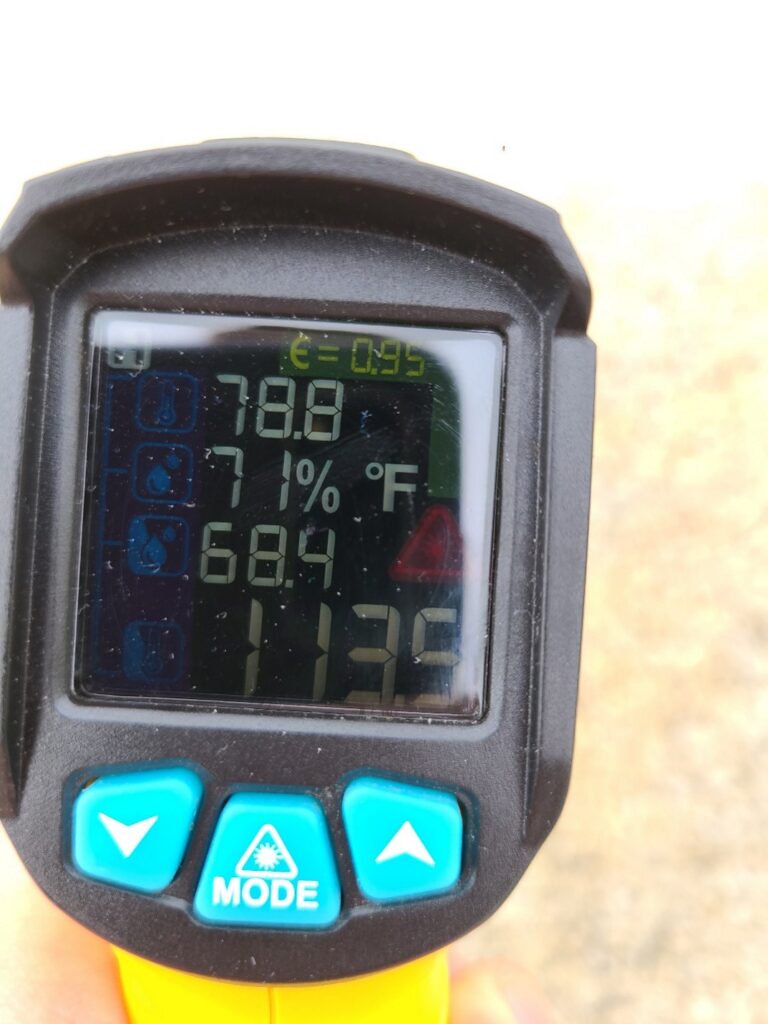
This one really surprised us at 113 degrees Fahrenheit. We didn’t expect the sidewalk to be cooler than artificial turf, but the difference could be accounted for by local factors such as shade from the clouds and slightly different ambient temperatures. Regardless, the nearly 30-degree Fahrenheit difference between natural grass and the sidewalk is staggering. It really puts things into perspective and highlights the importance of diligent temperature monitoring for dog owners and caretakers. Injury occurs on these surfaces quicker than you’d suspect—and dogs aren’t necessarily great at communicating or understanding what is wrong.
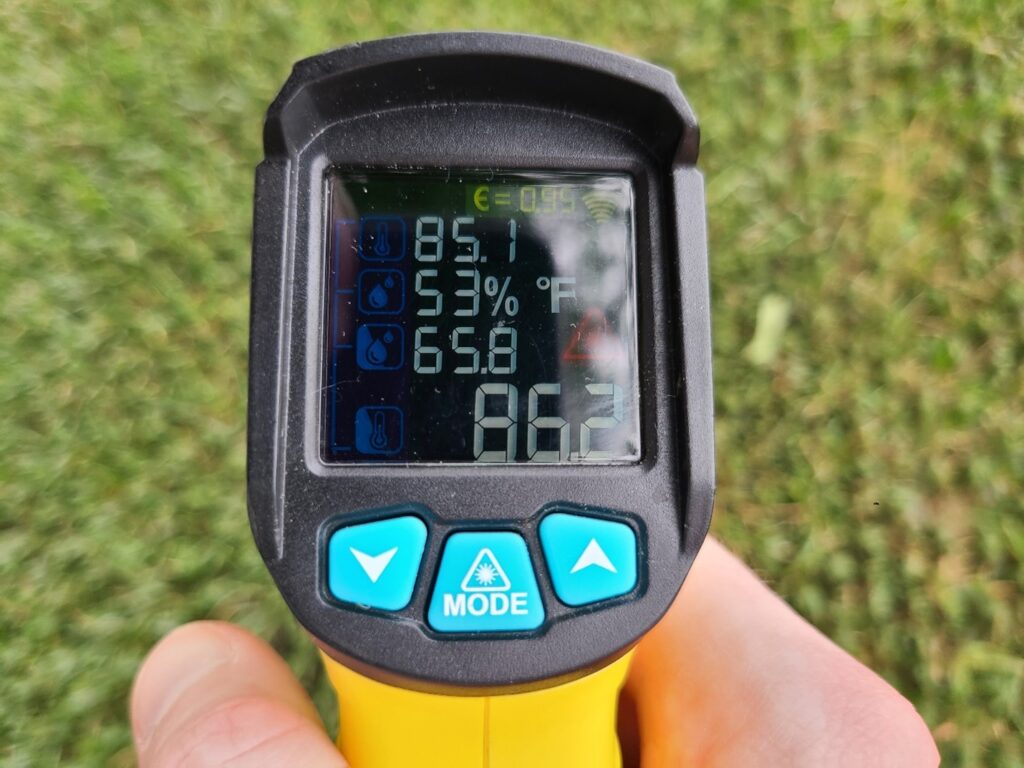
Coming in at 86.2 degrees Fahrenheit, we were thrilled to find that Natura turf reacts to heat similarly to natural grass. When designing Natura, we strived to create a surface that combined all the benefits of artificial turf with those of natural grass—and heat was a main concern during the design and manufacturing process.
Natura contains UV stabilizers to keep it from degrading under the sun. Natura turf is also formulated with infrared reflective pigment to prevent the turf from absorbing too much heat and becoming dangerously hot.
Grass manages to stay at a safe surface temperature for dogs even on a 90 degree day in St. Louis, Missouri.
Other surfaces like traditional artificial turf and asphalt are more likely to reach unsafe temperatures and require human discretion to determine if they’re safe to walk on during hot days.
Natura turf performs similarly to grass in hot weather, and its heat-dissipating properties are only projected to increase as more natural grass grows through the product.
It’s up to us dog owners and caretakers to keep our pooches in mind during hot weather. Most heat injuries are preventable given proper education, preparation, and diligence.
If you’re looking improve the safety and comfort of your facility, Natura turf comes at about a quarter of the installed price of traditional artificial turf and it’s green year-round, whether grass is dormant or lush. As you can see, Natura turf also delivers in the heat, so you have one less thing to worry about in hot weather.
Learn more about Natura turf here.
Subscribe
to our newsletter
Recent Posts
Contact us:
2381 Centerline Industrial Drive
St. Louis, MO 63146
Quick Links
© 2024 GrassWorx, LLC. All Rights Reserved. Natura™ is a trademark of GrassWorx, LLC. St. Louis, MO 63146.